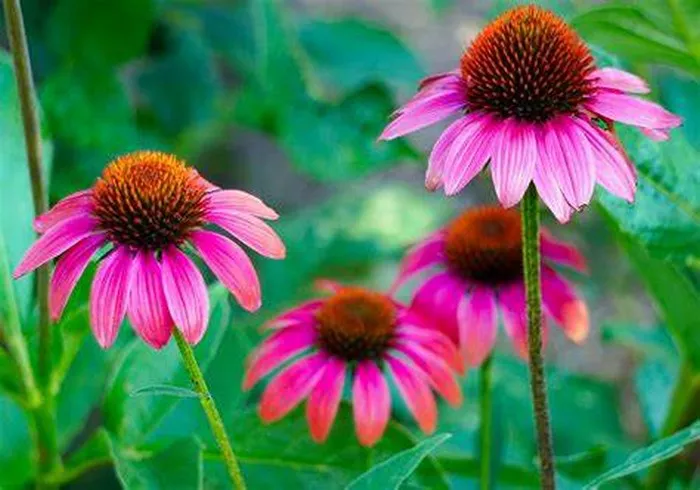Coneflowers, also known as Echinacea, are a beloved genus of flowering plants native to North America. These stunning perennials have captivated gardeners and naturalists alike with their vibrant hues, unique structures, and numerous medicinal properties. In this comprehensive guide, we delve into the anatomy, variations, significance, and cultivating techniques of coneflowers.
Anatomy of Coneflowers
Coneflowers belong to the Asteraceae family and are characterized by their distinct central cones surrounded by vibrant petals. Let’s explore their anatomy in more detail:
1. Central Cone: The most distinctive feature of coneflowers is their raised central cone, which is composed of numerous tiny individual flowers. This cone gives the plant its name and serves as a prominent feature in the garden.
2. Petals: Surrounding the central cone are the ray florets, which form the colorful petals of the flower. These petals can range in color from shades of purple, pink, and white to vibrant orange and yellow.
3. Leaves: Coneflower leaves are lance-shaped and typically arranged alternately along the stem. They have a slightly rough texture and may vary in size depending on the species and variety.
4. Roots: Beneath the soil, coneflowers develop a robust root system, consisting of both taproots and fibrous roots. These roots help anchor the plant and absorb nutrients and water from the soil.
5. Stem: The stem of a coneflower is typically sturdy and upright, branching out near the top to support multiple flower heads.
Variations of Coneflowers
Coneflowers exhibit a remarkable diversity of colors, sizes, and forms, making them a versatile choice for gardeners. Some of the most popular variations include:
1. Echinacea purpurea: This species is perhaps the most well-known and widely cultivated, featuring classic pink-purple petals and a prominent cone. It is a favorite among pollinators and gardeners alike.
2. Echinacea angustifolia: Native to the western United States, this species is characterized by its narrow leaves and vibrant purple petals. It is also valued for its medicinal properties.
3. Echinacea pallida: Known for its pale pink petals and drooping petals, E. pallida adds a delicate touch to garden borders and prairie plantings. It is particularly attractive to butterflies and other pollinators.
4. Double-flowered Varieties: Breeders have developed double-flowered coneflower varieties, which feature multiple layers of petals around the central cone, resembling a pompom. These cultivars often come in a range of colors, from creamy white to deep magenta.
5. Yellow and Orange Varieties: While purple is the most common color among coneflowers, there are also striking yellow and orange varieties available. These sunny-hued flowers add a pop of color to any garden and are highly attractive to bees and butterflies.
Significance of Coneflowers
Beyond their aesthetic appeal, coneflowers hold cultural, ecological, and medicinal significance:
1. Cultural Symbolism: Coneflowers have been revered by Native American tribes for centuries for their medicinal properties and spiritual significance. They are often associated with strength, resilience, and healing.
2. Ecological Importance: Coneflowers play a crucial role in supporting pollinators such as bees, butterflies, and hummingbirds. Their nectar-rich flowers provide a vital food source for these insects, contributing to the overall biodiversity of the ecosystem.
3. Medicinal Uses: Traditionally, various species of coneflowers have been used in herbal medicine to treat a range of ailments, including colds, flu, infections, and inflammation. Today, echinacea supplements are popular for their immune-boosting properties and are widely used in alternative medicine.
4. Garden Ornamental: In addition to their ecological and medicinal value, coneflowers are prized for their ornamental beauty. They are a staple in perennial gardens, prairie plantings, and wildflower meadows, adding color and texture throughout the growing season.
Cultivating Coneflowers
Cultivating coneflowers is relatively straightforward, making them an excellent choice for both novice and experienced gardeners. Here are some tips for successful cultivation:
1. Site Selection: Choose a sunny location with well-drained soil for planting coneflowers. While they can tolerate some shade, they thrive in full sun conditions.
2. Soil Preparation: Prepare the soil by amending it with organic matter, such as compost, to improve drainage and fertility. Coneflowers prefer slightly alkaline soil with a pH of 6.0 to 7.0.
3. Planting: Plant coneflower seeds or seedlings in the spring after the last frost date. Space them 18 to 24 inches apart to allow for adequate air circulation and prevent overcrowding.
4. Watering: Water newly planted coneflowers regularly to establish a strong root system. Once established, they are drought-tolerant and only require occasional watering during prolonged dry spells.
5. Mulching: Apply a layer of organic mulch, such as shredded bark or straw, around the base of the plants to conserve moisture and suppress weeds.
6. Deadheading: Remove spent flower heads regularly to encourage continuous blooming throughout the season and prevent self-seeding.
7. Dividing: Every few years, divide mature coneflower clumps to rejuvenate the plants and promote healthier growth. Dig up the clump in early spring or fall, and carefully separate the individual crowns before replanting them.
8. Pest and Disease Control: Coneflowers are relatively pest and disease-resistant but may occasionally be susceptible to aphids, powdery mildew, and aster yellows. Monitor plants regularly and treat any infestations promptly with organic insecticidal soap or fungicides.
By following these cultivation tips, you can enjoy the beauty and benefits of coneflowers in your garden year after year.
Conclusion
In conclusion, coneflowers are more than just a pretty face in the garden; they are symbols of resilience, biodiversity, and natural healing. From their striking anatomy and diverse variations to their cultural significance and ecological importance, coneflowers continue to inspire and enchant gardeners and nature enthusiasts around the world. With proper care and cultivation, these delightful perennials will thrive in your garden, bringing joy and vitality for generations to come.


